Naturally occurring substitutions in the P/V gene convert the noncytopathic paramyxovirus simian virus 5 into a virus that induces alpha/beta interferon synthesis and cell death
- PMID: 12239285
- PMCID: PMC136585
- DOI: 10.1128/jvi.76.20.10109-10121.2002
Naturally occurring substitutions in the P/V gene convert the noncytopathic paramyxovirus simian virus 5 into a virus that induces alpha/beta interferon synthesis and cell death
Abstract
The V protein of the paramyxovirus simian virus 5 (SV5) is responsible for targeted degradation of STAT1 and the block in alpha/beta interferon (IFN-alpha/beta) signaling that occurs after SV5 infection of human cells. We have analyzed the growth properties of a recombinant SV5 that was engineered to be defective in targeting STAT1 degradation. A recombinant SV5 (rSV5-P/V-CPI-) was engineered to contain six naturally occurring P/V protein mutations, three of which have been shown in previous transfection experiments to disrupt the V-mediated block in IFN-alpha/beta signaling. In contrast to wild-type (WT) SV5, human cells infected with rSV5-P/V-CPI- had STAT1 levels similar to those in mock-infected cells. Cells infected with rSV5-P/V-CPI- were found to express higher-than-WT levels of viral proteins and mRNA, suggesting that the P/V mutations had disrupted the regulation of viral RNA synthesis. Despite the inability to target STAT1 for degradation, single-step growth assays showed that the rSV5-P/V-CPI- mutant virus grew better than WT SV5 in all cell lines tested. Unexpectedly, cells infected with rSV5-P/V-CPI- but not WT SV5 showed an activation of a reporter gene that was under control of the IFN-beta promoter. The secretion of IFN from cells infected with rSV5-P/V-CPI- but not WT SV5 was confirmed by a bioassay for IFN. The rSV5-P/V-CPI- mutant grew to higher titers than did WT rSV5 at early times in multistep growth assays. However, rSV5-P/V-CPI- growth quickly reached a final plateau while WT rSV5 continued to grow and produced a final titer higher than that of rSV5-P/V-CPI- by late times postinfection. In contrast to WT rSV5, infection of a variety of cell lines with rSV5-P/V-CPI- induced cell death pathways with characteristics of apoptosis. Our results confirm a role for the SV5 V protein in blocking IFN signaling but also suggest new roles for the P/V gene products in controlling viral gene expression, the induction of IFN-alpha/beta synthesis, and virus-induced apoptosis.
Figures

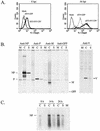
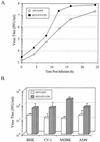

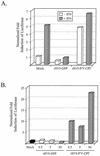

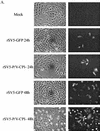

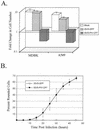

Similar articles
-
A simian virus 5 (SV5) P/V mutant is less cytopathic than wild-type SV5 in human dendritic cells and is a more effective activator of dendritic cell maturation and function.J Virol. 2006 Apr;80(7):3416-27. doi: 10.1128/JVI.80.7.3416-3427.2006. J Virol. 2006. PMID: 16537609 Free PMC article.
-
Apoptosis induction and interferon signaling but not IFN-beta promoter induction by an SV5 P/V mutant are rescued by coinfection with wild-type SV5.Virology. 2003 Nov 10;316(1):41-54. doi: 10.1016/s0042-6822(03)00584-1. Virology. 2003. PMID: 14599789
-
Growth sensitivity of a recombinant simian virus 5 P/V mutant to type I interferon differs between tumor cell lines and normal primary cells.Virology. 2005 Apr 25;335(1):131-44. doi: 10.1016/j.virol.2005.02.004. Virology. 2005. PMID: 15823612
-
[Sendai virus proteins counteracting the host innate immunity].Uirusu. 2004 Dec;54(2):179-88. doi: 10.2222/jsv.54.179. Uirusu. 2004. PMID: 15745155 Review. Japanese.
-
Paramyxovirus activation and inhibition of innate immune responses.J Mol Biol. 2013 Dec 13;425(24):4872-92. doi: 10.1016/j.jmb.2013.09.015. Epub 2013 Sep 20. J Mol Biol. 2013. PMID: 24056173 Free PMC article. Review.
Cited by
-
Mumps virus V protein antagonizes interferon without the complete degradation of STAT1.J Virol. 2005 Apr;79(7):4451-9. doi: 10.1128/JVI.79.7.4451-4459.2005. J Virol. 2005. PMID: 15767445 Free PMC article.
-
A simian virus 5 (SV5) P/V mutant is less cytopathic than wild-type SV5 in human dendritic cells and is a more effective activator of dendritic cell maturation and function.J Virol. 2006 Apr;80(7):3416-27. doi: 10.1128/JVI.80.7.3416-3427.2006. J Virol. 2006. PMID: 16537609 Free PMC article.
-
Role for the phosphoprotein P subunit of the paramyxovirus polymerase in limiting induction of host cell antiviral responses.J Virol. 2007 Oct;81(20):11116-27. doi: 10.1128/JVI.01360-07. Epub 2007 Aug 8. J Virol. 2007. PMID: 17686837 Free PMC article.
-
Replication-independent activation of human plasmacytoid dendritic cells by the paramyxovirus SV5 Requires TLR7 and autophagy pathways.Virology. 2010 Sep 30;405(2):383-9. doi: 10.1016/j.virol.2010.06.023. Epub 2010 Jul 6. Virology. 2010. PMID: 20605567 Free PMC article.
-
Parainfluenza Virus 5 V Protein Blocks Interferon Gamma-Mediated Upregulation of NK Cell Inhibitory Ligands and Improves NK Cell Killing of Neuroblastoma Cells.Viruses. 2024 Aug 9;16(8):1270. doi: 10.3390/v16081270. Viruses. 2024. PMID: 39205244 Free PMC article.
References
-
- Atreya, P. L., and S. Kulkarni. 1999. Respiratory syncytial virus A2 is resistant to the antiviral effects of type I interferons and human MxA. Virology 261:227-241. - PubMed
-
- Baumgartner, W. K., S. Krakowka, and B. Durchfeld. 1991. In vitro cytopathogenicity and in vivo virulence of two strains of canine parainfluenza virus. Vet. Pathol. 28:324-331. - PubMed
-
- Biron, C. A., and G. C. Sen. 2001. Interferons and other cytokines, p. 321-349. In D. Knipe, P. Howley, D. Griffin, et al. (ed.), Fields virology, 4th ed. Lippincott-Raven Publishers, Philadelphia, Pa.
Publication types
MeSH terms
Substances
Grants and funding
LinkOut - more resources
Full Text Sources
Other Literature Sources
Research Materials
Miscellaneous

